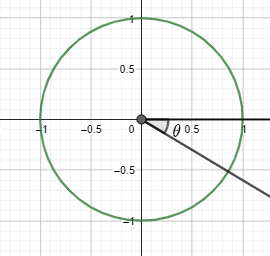
How do you evaluate arctan (-1) using a unit circle?
Answer
419.7k+ views
Hint: It is clearly understood that we need to do all the calculation part using a circle and that too with a unit circle where obviously we take radius as 1 in the defined unit. Arctan (-1) obviously we know that we want to evaluate the inverse of tangent function at -1.
Complete step-by-step answer:
We will use the unit circle that is a circle of radius 1 which will have its centre at origin which is (0,0) and here the tangent of theta angle that is $\tan (\theta )$ is the y coordinate value divided by the x coordinate value of the intersection of the unit circle and a ray which is extending from the origin making an angle theta.

Now finding the inverse of tangent at -1 or arctan (-1) is the same as evaluating for theta in $\tan \theta $ =-1.
This will happen when x and y have equal magnitudes or values what we normally say but have the opposite signs within the defined domain of theta as $\theta \in [0,2\pi ]$ and this happens only at some particular values of theta.
And as per the requirement of the question we get this case true only when $\theta =\dfrac{3\pi }{4}$ and will also be true when $\theta =\dfrac{7\pi }{4}$ .
Note: We must be aware of the angles and signs that we need to take for particular angles as the value of the functions differ with signs obviously. Also we must remember the rotation and signs we take for various trigonometric angles.
Complete step-by-step answer:
We will use the unit circle that is a circle of radius 1 which will have its centre at origin which is (0,0) and here the tangent of theta angle that is $\tan (\theta )$ is the y coordinate value divided by the x coordinate value of the intersection of the unit circle and a ray which is extending from the origin making an angle theta.

Now finding the inverse of tangent at -1 or arctan (-1) is the same as evaluating for theta in $\tan \theta $ =-1.
This will happen when x and y have equal magnitudes or values what we normally say but have the opposite signs within the defined domain of theta as $\theta \in [0,2\pi ]$ and this happens only at some particular values of theta.
And as per the requirement of the question we get this case true only when $\theta =\dfrac{3\pi }{4}$ and will also be true when $\theta =\dfrac{7\pi }{4}$ .
Note: We must be aware of the angles and signs that we need to take for particular angles as the value of the functions differ with signs obviously. Also we must remember the rotation and signs we take for various trigonometric angles.
Recently Updated Pages
Master Class 12 Economics: Engaging Questions & Answers for Success

Master Class 12 Maths: Engaging Questions & Answers for Success

Master Class 12 Biology: Engaging Questions & Answers for Success

Master Class 12 Physics: Engaging Questions & Answers for Success

Master Class 12 Business Studies: Engaging Questions & Answers for Success

Master Class 12 English: Engaging Questions & Answers for Success

Trending doubts
What is the Full Form of PVC, PET, HDPE, LDPE, PP and PS ?

What are the major means of transport Explain each class 12 social science CBSE

Draw a neat and well labeled diagram of TS of ovary class 12 biology CBSE

When was the first election held in India a 194748 class 12 sst CBSE

What is pseudocoelom Where is it located class 12 biology CBSE

State the postulates of special theory of relativi class 12 physics CBSE




